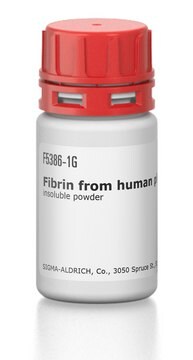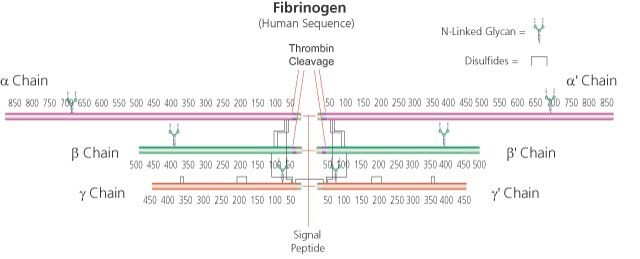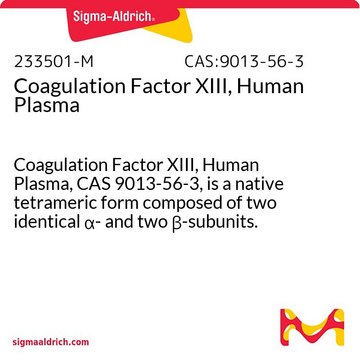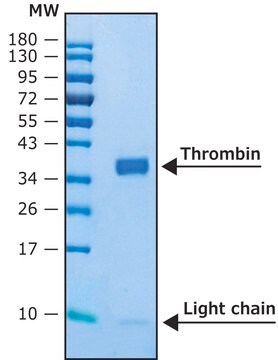F4883
Fibrinogênio
35-65% protein (≥90% of protein is clottable).
Sinônimo(s):
Fator I
About This Item
Produtos recomendados
fonte biológica
human plasma
Nível de qualidade
descrição
essentially plasmin(ogen) free
forma
powder
qualidade
35-65% protein (≥90% of protein is clottable).
peso molecular
α-chain 63.5 kDa
β-chain 56 kDa
γ chain 47 kDa (about 4% carbohydrate content)
soluble dimer 340 kDa
concentração
35-65% protein (biuret)
técnica(s)
cell culture | mammalian: suitable
solubilidade
0.9% NaCl: soluble
temperatura de armazenamento
−20°C
Procurando produtos similares? Visita Guia de comparação de produtos
Descrição geral
Aplicação
- fibrinogen adsorption assay performed on swCNTs (single-walled carbon nanotubes)
- the characterization of fibrinogen structure in the presence of CNT using CD (Circular dichroism) spectroscopy and temperature scan
- the preparation of RBC suspension obtained from venous blood of antecubital vein, to assess RBC aggregability
- fibrinolysis assay performed on mouse embryonic fibroblasts (MEFs)
- the preparation of fibrinogen-labeled gold (Fgn/Au)
- the quantification of in vitro angiogenesis by human microvascular endothelial cells and
- the assessment of fibrin-induced apoptosis and differentiation-regulation in trophoblast obtained from term human placentas.
Ações bioquímicas/fisiológicas
Especificações
forma física
Nota de análise
Exoneração de responsabilidade
Código de classe de armazenamento
11 - Combustible Solids
Classe de risco de água (WGK)
WGK 3
Ponto de fulgor (°F)
Not applicable
Ponto de fulgor (°C)
Not applicable
Equipamento de proteção individual
Eyeshields, Gloves, type N95 (US)
Certificados de análise (COA)
Busque Certificados de análise (COA) digitando o Número do Lote do produto. Os números de lote e remessa podem ser encontrados no rótulo de um produto após a palavra “Lot” ou “Batch”.
Já possui este produto?
Encontre a documentação dos produtos que você adquiriu recentemente na biblioteca de documentos.
Os clientes também visualizaram
Nossa equipe de cientistas tem experiência em todas as áreas de pesquisa, incluindo Life Sciences, ciência de materiais, síntese química, cromatografia, química analítica e muitas outras.
Entre em contato com a assistência técnica









